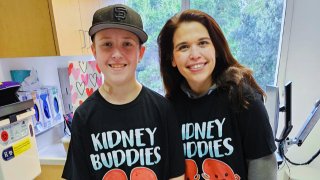

The following content is created in partnership with Stanford Medicine Children’s Health. It does not reflect the work or opinions of the NBC Bay Area editorial staff. Click here to learn more about the transplant services at Stanford Medicine Children’s Health.
While most of us know that organ donations save lives, the generous act often connotes morbidity or disaster, and many believe that donations can only occur between family members. What’s less understood is the critical needs of everyday patients and the medical advances that now enable living donations. For example, 103,981 people are currently on the national transplant waiting list, including more than 2,100 children. Furthermore, it’s possible for generous people to donate certain organs while continuing to lead happy healthy lives like Sarah Best, a 40-year-old from Sacramento who saved a life by donating one of her kidneys to 14-year-old Jaxon Shaneyfelt. The following numbers further highlight the importance of living organ donors and demonstrate just how impactful a donation can be.
85 percent of patients
Get a weekly recap of the latest San Francisco Bay Area housing news. Sign up for NBC Bay Area’s Housing Deconstructed newsletter.
More than half of organ donation patients are in line for a kidney transplant, which is one of the donations that living people can choose to facilitate to save a life. Upon reading the Instagram post of a mutual friend, Sarah Best of Sacramento decided to do just that by donating one of her kidneys to 14-year-old Jaxon Shaneyfelt.
Shaneyfelt had been battling juvenile nephronophthisis, a fibrosis that leads to fatal kidney failure. Shaneyfelt’s mother was disheartened to learn that she would not be a compatible donor for her son, so she did the next best thing: she spread the word. Micah Shaneyfelt immediately began sharing Jaxon’s story on social media. “I knew it could take some time to find a match,” she said, “so I needed to get the word out every way I could.” Soon, their tight-knit community rallied around them and spread the word on behalf of the Shaneyfelts. News traveled from friend to friend-of-friend and beyond until reaching Sarah Best, an altruistic stranger with a universal blood-type who was moved by Jaxon's story. Just 24 hours after Best became a living kidney donor to Jaxon, his kidney function started improving.
By Christmas Day, the teenager had finally achieved normal kidney function, a triumph his mother, Micah Shaneyfelt, considered a “Christmas miracle.”
1 Person can save 8 lives
With regard to deceased organ donations, one donor can save up to eight lives and enhance 75 more through eye and tissue donation. Two donated kidneys can free two patients from dialysis treatments, and critical organ donations like heart, lung, and kidney can save several more with just a signature on a driver’s license or enrollment form. Even a living donor like Best can save two lives; donating a lifesaving organ to Shaneyfelt takes him off the transplant list, offering new hope to the next person.
Best, Shaneyfelt’s organ donor, said, “I just kind of knew I could help. It may sound weird, but I just had this feeling. I'm O-negative, so I know I'm a universal donor. I've always done blood donations, and I can do plasma donations. I think in the back of my head, I always wanted to be able to help on a bigger level."
9 Minutes
Every 9 minutes, a new patient is added to the nation’s transplant waiting list. That’s an average of 90 new people added to the catalog every day, an expanding number that becomes almost impossible to dilute without qualified medical professionals and the help of those willing to become living organ donors like Shaneyfelt’s lifesaver, Best.
The success of Shaneyfelt’s and Best’s living organ donation was made possible by a surgery accomplished by the hands of specialized surgeons at Stanford Medicine Children’s Health Pediatric Transplant Center.
Carlos Esquivel, MD, pediatric transplant surgeon at the Bay Area hospital emphasized range of care necessary to treat a case like Shaneyfelt’s: “We have to manage these patients when they have organ failure, then do the surgeries, take care of them post-operatively. I think we have the best team in the world [to do that].”
20 People
Every single day, 20 people die from the effects of organ failure while waiting, ranging from eight kilo newborn babies to centenarians. Many of the factors that contribute to the shortage of organ donors can be summed up to misconceptions and a lack of awareness. Indeed, the decision to register as an organ donor is not an insignificant one, but many adults, and parents on behalf of their children, are often dissuaded by far flung myths. For example, many believe that a terminal patient won’t receive the same level of care once they are seen as a donor, or that there are costs associated with organ removal; in fact, donor status does not affect access to lifesaving treatments, nor does it cost the donor anything. Perhaps one of the more pervasive misconceptions is that only deceased patients can donate, when in fact living donors can donate certain organs like the liver or kidney. Dispelling these myths could help address the organ shortage and encourage more heroes like Sarah Best to register as donors or become living donors.
“It was really awesome for it to all come full circle,” said Best. “To see the look on his parents' faces, their pure joy. To see that there is so much weight off their shoulders. It was honestly an honor to be able to shake their hands and give them hugs. He's just such a brave kid. I can't imagine being 13, 14 and knowing you have that need, and hoping someday you get that. It just makes me want to have more kidneys to give to more people.”
6,900 transplants
In 2023 alone, just under 7,000 transplants were made possible by living organ donors. That’s almost 7,000 living people–brothers, neighbors, daughters, parents, friends–that were gifted a new chance at life with their loved ones thanks to the generosity of benevolent friends and strangers alike that decided to give in a big way. Stanford Medicine Children’s Health currently attends fifty patients waiting for a transplant.
Shaneyfelt’s donor added, “I don't have to be on long term medication like he does. There's nothing really, I have to do, I just have to let the body heal. He has a bigger fight than I do on a daily basis because of his pain and discomfort. He seems to be doing really well, so that just makes me feel much better."
While checking ‘organ donor’ on a driver's license or registration form is itself a selfless act, some like Sarah Best wish to be a part of something greater. Join the national transplant list as a living donor, and give the greatest gift of all.
Stanford Medicine Children’s Health’s Pediatric Transplant Center provides pediatric care for those suffering from a variety of internal ailments. To learn more about organ donation and discover how you can save a life today, please click here.

